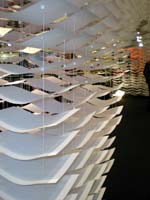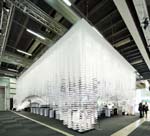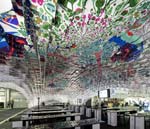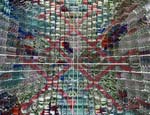
|

|
|
Home Site Search Contact Us Subscribe
|
|
|
How an Architect Stole the Stockholm Furniture Show Gert Wingårdh's architectural folly proves the extraordinary power of architecture, even when a building lasts just four days. By Linda Hales February 19, 2013 At the recent Stockholm Furniture & Light Fair, a fleeting work of architecture provided the lasting image.
It was a paper pavilion designed by Swedish architect Gert Wingårdh of Wingårdh Arkitektkontor. At first glance, the structure resembled an avalanche unleashed by a malfunctioning copier. Sheets of white paper floated to the rafters inside the main exhibition hall. Wingärdh had built this fragile Pantheon by suspending 11,000 pieces of copier paper on rolls of string.
“It was labor intense,” says Wingårdh, whose international practice in Gothenburg, Sweden, has produced such landmarks as the embassy of Sweden in Washington D.C.
Stockholm Design Week, which ended February 9, is a go-to event for timeless modern furniture, and there was plenty to admire among the sleek laminate chairs and elegant sound-dampening systems. But Wingårdh’s architectural folly generated the greater awe, along with hushed voices. As a work of architecture, it is both simple and complex. To make this church-like space, each sheet of paper had to be fixed by hand at four points – 44,000 points in all – before being strung from a superstructure and raised up like Venetian blinds.
The fair organizers had asked for a 200-square-meter enclosure for a symposium on “the art of communicating design.” This “Hello!” show was to be the intellectual heart of the fair. The analog architecture achieved icon status, even in a digital age.
Visitors could not miss the façade of white walls, which fluttered above the furniture displays. But that was only half the picture. Organizers had paired Wingårdh with the Finnish-born illustrator Kustaa Saksi of Amsterdam. He added a kaleidoscopic painting of mysterious sea creatures as a ceiling mosaic. The image was printed on hundreds of dangling sheets of paper and experienced only by those who ventured inside. Saksi’s interpretation of the theme was expressed as an otherworldly “Darwinistic evolution. Constantly on the move and a work in progress, like bacteria and marine animals when they crawled out of the depths of the sea millions of years ago.” With a message like that, it’s hard for tables and chairs to compete.
The architect had no trouble sharing glory. “I was turned on to architecture in the early ‘70s by a visit to Rome and the baroque churches,” Wingårdh says. There was basically a plain floor with a gorgeous roof. All the art was in the section viewed from below.”
Using paper came naturally. “It was readily available in our office” as well as reusable, he says. “It was also a twist on the love all architects feel for graceful, Japanese paper walls.”
And yet, a paper palace was not Wingårdh’s first instinct. He envisioned birdcages overhead, but regulations prohibited live creatures and their droppings. “By this time we had built up our knowledge of the artist and decided upon an idea of presenting his picture in some way suspended from the ceiling,” Wingärdh says. He credits five members of his Stockholm office – Beatrice Fägnell, Filip Mesko, Stefano Mangili, Axel Wolgers, and Anna Höglund – for the final idea. “I fell for it directly,” he says.
For furniture, the architect’s Gothenburg office stacked 700,000 sheets of paper like pillars to support mirrored laminate tabletops, which reflected the ceiling painting. The tables were arranged like church pews facing an altar-like podium.
A Finnish company, Stora Enso, donated all the paper. YouTube preserves the construction in a time-lapse video. Long after the structure is recycled, the memory of this paper Pantheon will dominate the furniture fair. That’s the extraordinary power of architecture, even when a building lasts just four days.
Linda Hales, former design critic for The Washington Post, writes about design and architecture. Her view of contemporary Washington architecture appears in Metropolis magazine at http://www.metropolismag.com/story/20101020/the-bell-jar. |
(click on pictures to enlarge)  Linda Hales Gert Wingårdh’s “Hello!” pavilion was a paper Pantheon to communication.  Tord-Rikard Söderström The 200-square-meter pavilion, made of 11,000 sheets of paper, each fixed by hand at four points, hosted a symposium on “the art of communicating design.”  Tord-Rikard Söderström The white “walls” of the façade fluttered above the furniture displays.  Tord-Rikard Söderström Kustaa Saksi’s kaleidoscopic painting of mysterious sea creatures created a ceiling mosaic.  Tord-Rikard Söderström Detail of Saksi’s ceiling  Tord-Rikard Söderström Mirrored laminate tabletops reflecting the ceiling mosaic sat atop pillars made of 700,000 sheets of paper, and arranged like church pews facing an altar-like podium. |
© 2013 ArchNewsNow.com